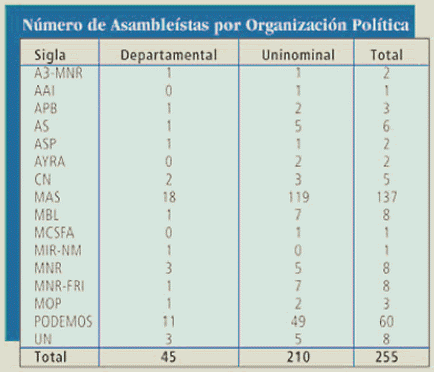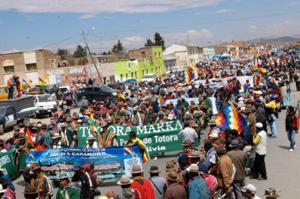|
What was the Constituent Assembly and how did it come about?
Demands for a Constituent Assembly to rewrite Bolivia's present constitution, making it more inclusive and representative, were first voiced in the 1990s. The previous constitution dates from 1967, although this has undergone several important reforms since then. It was only in 2003, however, that demands for constitutional reform became irresistible. Following the collapse of the Sánchez de Lozada government, the protesters' so-called 'October Agenda' included the matter as a key point, and the subsequent Mesa administration was forced to acknowledge the need for comprehensive reform. One of the main points on the reform agenda was to make the country more inclusive, drawing indigenous peoples in particular into the political sphere.
However, it was only when Evo Morales took over as president in January 2006 that this received priority. One of Morales' first moves was to announce a timetable for the Assembly. Elections were set for July 2, 2006, and August 6 (Bolivia's Independence Day) was designated for the installation of the new Assembly. The Assembly would sit for up to a year in Sucre, the country's legal capital. Its recommendations would need to be approved by a two-thirds majority and then be submitted to a national referendum for final approval.
Results
The elections were duly held, with Morales' ruling MAS (Movimiento al Socialismo) party winning 54% of the vote - roughly the same as its percentage of the vote in the preceding presidential elections of December 2005. Irrespective of their final share of the vote, however, the MAS had already agreed in a congressional discussion of the law guiding the election procedure, to a structure which would deny them the two thirds of seats required to be able to push through suggested reforms unaided. In the event the MAS won 137 seats out of a total of 255. The right-wing Podemos party (run by former President Jorge Quiroga) won 60 seats and a number of smaller parties the remainder.

Inauguration
The inauguration of the Assembly took place, as planned, on 6 August 2006 in Sucre, amid an impressive show of public support for the reform exercise. The presidency of the Constituent Assembly went to Silvia Lazarte from the MAS, a women's leader originally from among the coca workers of the Chapare. Initiation of the proceedings was hampered by disagreements over the voting rules to be adopted. The majority MAS argued that a majority of 50% plus one would suffice for each article, subject to a two-thirds vote at the conclusion of the Assembly's deliberations. The opposition parties argued in favour of a two-thirds majority on all resolutions, a proposal that would greatly increase their leverage (as well as tending to slow proceedings, by subjecting even the simplest administrative matter such as approving time off for a delegate to the two-thirds requirement).
Capitalía
An unexpected divisive issue in the assembly was an attempt to transfer the seat of government of the country from La Paz to Sucre. Sucre is the capital city of Bolivia, but only the Judiciary sit there. The issue of the capital city was seized upon by political leaders in Sucre and promoted as a way to bring economic development to the region, one of the poorest in Bolivia. This led to divisions within the assembly: most MAS assembly members opposed the transfer of the seat of government, seeing the issue as a regional demand that was not in the interests of the country as a whole, while the pro-autonomy opposition allied itself to those calling for the move. Local sentiments were stirred up and when the issue of the capitalía was excluded from discussions in August 2007, opposition supporters began to protest and block access to the assembly in an attempt to shut it down. These protests were tinged with racism and violence towards indigenous people and government supporters.
Approval of final text
As the situation deteriorated, and threats and attacks on assembly members escalated, it became impossible for the assembly to meet in Sucre. This situation continued for three months, but as the December 2007 deadline for the approval of the final constitutional text approached, it was decided that the assembly would convene in an alternative venue. In late November, the assembly was moved first to a military school outside Sucre for one session, then to the Technical University of Oruro where it reconvened to approve each article of the text in a single marathon session. A few days later, the final version of the new Bolivian constitution was delivered to president Evo Morales in La Paz, amidst a delighted crowd of supporters, particularly indigenous people.
Consensus and ratification
Following the upsurge in violence in the eastern lowlands in September 2008, the government and opposition entered into dialogue in an attempt to resolve some of the main points of disagreement between them, including some aspects of the constitutional text. The dialogue passed from the president and opposition prefects to the national Congress, where over 100 modifications to the constitutional text were made. This allowed a consensus to be reached and the Congress was able to call a national referendum to ratify the new constitution into law. A supplementary question was included in the referendum to decide how the upper-limits on land-holding would be defined in the constitution. Voters were given a choice between either a five or ten thousand hectare limit.
The referendum was held on 24 January 2009 and the constitution was ratified with a 61% ‘yes’ vote. The five thousand hectare limit won the supplementary vote, with an 80.65% majority. See Results.
Key features of the new constitution
The new constitution can be downloaded in Spanish here. The key points of the 414 point constitution include:
- Indigenous rights. Indigenous peoples, long excluded from effective decision-making, have won substantially enhanced political rights.
- Autonomies. A system of decentralised government will be introduced to cater for the demands expressed by the media luna departments. Departmental autonomies will be complemented by regional, municipal and indigenous autonomies.
- Justice. New provisions are included to provide for traditional forms of justice in those areas that are governed by indigenous peoples.
- State control. The new constitution assumes a greater degree of state control over the use and exploitation of natural resources.
- Private property. The constitution gives guarantees for the sanctity of private property, alongside communal and state property.
- Presidential re-election. The new constitution removes the legal bar to immediate re-election. However, Morales has said that – if re-elected in 2009 – he would not stand for a further term in 2014. This was part of the political agreement with the opposition.
- Land reform. Land-holding limits have been set at 5,000 hectares. To assuage opposition fears, the government has agreed that the effect of this will not be made retroactive. The opposition conceded that land reform will be controlled by the central government and not administered at the regional level.
- Church and state. There will be a formal separation of Church and state.
See also: Delegates agree to extend the period of the Constituent Assembly
Capital City: Sucre or La Paz?
Bolivia: a tale of two (or rather three) cities
New constitution outlined
Bolivia's Controversial Constitution
The Bolivian Constitution and Religion
BIF Briefing on the constitutional referendum, January 2009
Bolivia: after the vote
Final referendum results (official)
|




